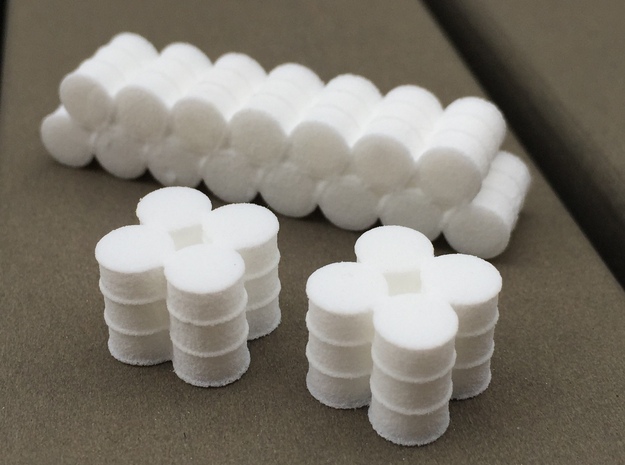
Shapeways shop owner Dain Penman of MadasU shares some insights into choosing the right material for printing scale objects meant to be part of a larger train set.
When you are looking at a model to purchase, the material choices available can be confusing. While some models are offered in only a single material, others are offered in multiple materials which have different characteristics. Where a model is only offered in one material, sometimes you want to understand why. Let’s explore the main material options used for scale models:
Strong and flexible plastic – this plastic comes in a variety of colors and finishes. The finishes available are unpolished which is only black and white or polished which includes white and a range of seven great colors. This material is fairly flexible, depending on thickness but quite strong. The finish does show print lines or ‘stepping’ although this can generally be taken care of with some post-production light sanding and painting. This can be seen in the barrels.
Metallic plastics – available in both polished and unpolished. Very similar to strong and flexible plastic, although comes in a metallic finish. This can be great when the model is either entirely or in part based on a metal prototype as you won’t need to paint the model before placing it. Have a look at the corrugated iron water tank for an example of metallic plastic.
Acrylic plastics (black, white and transparent) – These are more detailed plastics than the strong and flexible plastics, but still have thicker wall requirements. So they are good for showing surface detail on a model, but not good for fine pieces like thin walls or wires.
Frosted detail plastics – the two frosted detail plastics (ultra and extreme) allow for the finest level of detail, with the smallest thicknesses of any product. This makes the material perfect for models with a lot of fine detail including thin walls or wires. While these models look great raw, they will need to be painted for a realistic effect. This material is the most expensive in terms of volume, but allows for finer details and thinner walls so the models are not necessarily more expensive.
So which material is best? The answer to this is entirely dependant on the model and how it was designed. Firstly, have a look if multiple options are available as often the designer will make the choice on your behalf. This will usually be a balance between the design and the cost, with the quality of the design the most important of the two. If you do have a choice, look at the price of each material as there are no absolutes with pricing. Some of my models are cheaper in the more expensive materials! Now you can compare the qualities of the different materials and determine the best choice!






It’s been several years now since I purchased 3 N Scale Locomotives in FUD. As usual some things dealing with health issues have gotten in the way, and now that I’m about ready to do something with the models, I need to know:
1. How long does the plastic last before coming apart (disintegrate)? Or does it?
2. What is best for cleaning (washing) and preparing the plastic for paint?
3. Is there a special prep coat chemical for the plastic to prepare it for paint?
4. What type of glue is best for securing other detail parts to the plastic (FUD)?
Thanks for your time…Dave.
Can you tell me what the different plastics are that are available? Is Urethane available? Can you add a uv inhibitor to any of the plastics. THANKS Byron Dixon
Hi Dave. Though I am not the author of the article, I thought I would at pass on what I know.
I can’t say how long the plastic will last. I have had some models at least as long as you have, and seen no change. As with any hand painted mini, keeping them out of direct sun and dust free will go a long way to preserving them.
For cleaning before painting, I prefer to use alcohol. It is much faster than some of the techniques I’ve seen described, and works equally well, near as I can tell.
For a prep coat, you can’t beat gesso. It is an artists primer used to prep canvas for painting. The only draw back might be that it can be grainy, but by mixing some gesso directly into your paint, you can get good adhesion and permanence. Plus you don’t have to deal with any toxic chemicals.
Best glue? Good old super glue, or cyanoacrylate. I prefer using the gel viscosity over liquid. It gives me just enough time to set the pieces before hardening.
Good luck, have fun!
J-